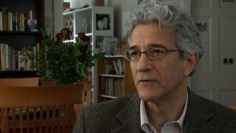LAURENCE REES: After talking to Jewish survivors, particularly in Lithuania, I felt it was interesting that they often suffered at the hands of people who they had lived happily next door to for years and years, often generations, and then with arrival of the Nazis it was almost like the violence was simply switched on. And this they seem simply to be unable to understand.
OMER BARTOV: It’s true and it’s jarring, of course, when people say, you know, the man who was the father of my girlfriend, we used to study together at home, and when the Germans came he became a police officer and he came and rounded up my family and took them to a mass killing. How is that possible? So that is true. But one also has to understand that there is a history to these inter-ethnic communities. These are communities, and that’s across all Eastern Europe, from the Baltic, from Lithuania and Latvia all the way to the Black Sea, all the way to the Balkans, these were mixed communities. And relations between these different communities that had persisted for centuries had been deteriorating at least since the beginning of modern nationalism. So at least since the late 19th Century. Then of course, in the 17th Century in Poland and the Ukraine, there were mass killings of Jews so there’s an earlier history to this. But from the late 19th Century religious differences between communities often defined the differences between different groups, and then grafted onto them is nationalism. These groups start seeing themselves as distinct from others and start seeing the other group as somehow in the way of its own fulfillment and its own identity as a group, and that the other group needs to somehow be removed. This does not mean necessarily that there are no alliances, that groups don’t work together as they depend on each other economically (because often the ethnic and religious differences are also reflected in economic professions, in what people do). But there is a preparation already for more violence.
When World War One comes, and we tend to forget World War One in many of these areas, it was devastating. It devastated communities, it devastated relations between people, it was horrendously bloody and the memory of that war remains during the 1920s and 30s. That’s crucial in many of these areas, that’s also in Lithuania, and Galicia, Eastern Poland, between 1939 and 1941, this area is taken over by the Soviet Union, and the Soviet Union does its own thing. They have their own policies regarding social classes, which are often identified also with ethnic groups. And there are massive deportations and they decimate the local elites. And so when the Germans march in they’re marching into an area that has already been through so much violence, and where the local elites and the relations between the different groups have been so greatly disturbed that violence is seething. And they, of course, make very good use of that for their own purposes. So it isn’t that it just happens out of the blue. But there is a difference, of course, because between all these precedents is the fact that your neighbour walks into your house and kills your family.
The personal nature of the cruelty in the East
Professor Omer Bartov

- The German Military mentality in the Soviet Union
- Progression of the brutality in the East
- The killing of Eastern Jews
- Why were Jewish women and children killed
- The personal nature of the cruelty in the East
- Judaism and Communism
- Prejudice against Jews
- The difference between Soviet and Nazi evil
- Ukrainian reactions to the Soviets
- A potential Soviet genocide
- Most important WW2 turning point
- The leader with most enhanced reputation
- Biggest mistake of WW2
- Why study history and WW2 in particular
 Twitter
Twitter




